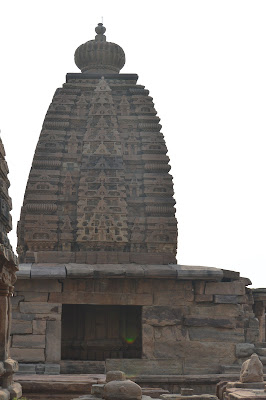BADAMI, PATTADAKALL AND AIHOLE OF KARNATAKA
(Cave temples and Sculptures)
On 06 04 22, we left Belgavi and reached Badami in the afternoon. After settling down in the Hotel and taking rest, we proceeded in the evening to Badami caves. The sculptural works in the 3 regions of Badami/Pattadakall/Aihole were all during Chalukya regime and Badami and Aihole had been capital for some time for Chalukyas. While Badami temples were carved out of the mountains and thus cave temples, Pattadakall was stone built temples and majority of the stone structures in Aihole too are stone built structures.
The Badami Chalukya era (7th and 8th century) was an
important period in the development of South Indian architecture. Their style
of architecture is called “Chalukyan architecture” or “Karnata Dravida
architecture”. Nearly a hundred monuments built by them, rock cut (cave) as
well as structural, and are found in the Malaprabha river basin in modern
Bagalkot district of northern Karnataka. The building material they used was
reddish-golden Sandstone found locally. Though they ruled a vast empire, The
Chalukyans concentrated most of their temple building activity in a
relatively small area within the Chalukyan heartland – Aihole, Badami,
Pattadakal and Mahakuta in modern Karnataka state.
The red sandstone cliffs of Badami offered a spectacular
setting for the excavation of four caves, three pertaining to the Hindu Pantheons and one Jaina
(Parshwavanath). Frist cave concentrates on the aspects of Lord Shiva and the second and the third Vishnu and his avatars.
The largest is Cave 3, dedicated
to Vishnu. An inscription next to a Varaha depiction states that Mangalesa, a
brother of King Kirtivarman, dedicated the cave in A.D. 578. Members of the
royal family of Chalukyas patronized many Chalukyan monuments. All of them were
created in 6th and 7th century. The architecture is a mixture of the Nagara
style and Dravida style. Apart from the above four, there is a fifth natural
Buddhist cave in Badami.
There is an entry ticket for Badami caves controlled by Archeological Survey of India. In the first cave, in a stone enclosure as we approach to our right, in the inner walls Lord Ganapathy on one side and Lord Subramanya on the other side are depicted. Around 25 steps are to be covered to reach the sculptures in the first cave and it is a small cave.
Nataraja with 18 hands is the main attraction here.
Further steps have to be covered to see the other caves. A few of the sculptural works in these areas have been shown here. Apart from that, one can also see the Boothnath temple by the side of the lake on the eastern side, once when we ascend to the 2nd cave.
There is an entry ticket for Pattadakall sculptures controlled by Archeological Survey of India.
































No comments:
Post a Comment